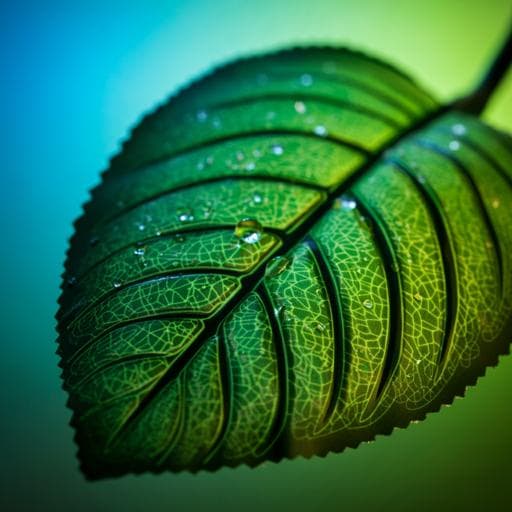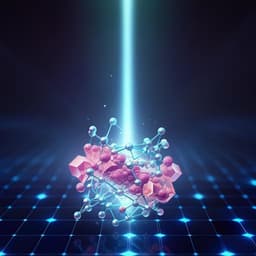
Environmental Studies and Forestry
Self-cycled photo-Fenton-like system based on an artificial leaf with a solar-to-H₂O₂ conversion efficiency of 1.46%
C. Dong, Y. Yang, et al.
Discover an innovative self-cyclable system that couples solar light-assisted H₂O₂ production with photo-Fenton-like reactions using an artificial leaf. Achieving an unassisted H₂O₂ production rate of 0.77 µmol/(min·cm²) and a solar-to-hydrogen peroxide efficiency of 1.46%, this research from Chaoran Dong, Yilong Yang, Xuemin Hu, Yoonjun Cho, Gyuyong Jang, Yanhui Ao, Luyang Wang, Jinyou Shen, Jong Hyeok Park, and Kan Zhang showcases the potential for decentralized wastewater purification using just water, oxygen, and sunlight.
~3 min • Beginner • English
Introduction
Advanced oxidation processes (AOPs) generate reactive oxygen species (ROS) capable of mineralizing diverse organic pollutants in water; among them, the Fenton reaction efficiently produces •OH but requires continuous input of chemical reagents (H₂O₂, iron salts, pH adjustment), greatly increasing cost. Heterogeneous photocatalysis offers greener ROS generation but is limited by fast electron–hole recombination and high thermodynamic barriers for radical formation. Combining photocatalysis with Fenton (photo-Fenton) still typically depends on externally supplied H₂O₂. Recent studies revealed bicarbonate (HCO₃⁻) can reversibly react with H₂O₂ to form peroxymonocarbonate (HCO₄⁻), assisting water-oxidative H₂O₂ evolution under photoelectrochemical (PEC) conditions and, together with H₂O₂, facilitating ROS formation via transition metal activation. Motivated by these correlations, the authors propose a self-cycled AOP system: solar-assisted in situ H₂O₂ production using an artificial leaf, immediate activation of H₂O₂ to ROS by Mn(II) in bicarbonate media, and electrochemical recycling of Mn redox states, enabling sustainable and low-cost wastewater treatment using only water, oxygen, and sunlight.
Literature Review
The work builds on extensive AOP and PEC literature: classic Fenton chemistry is effective but reagent-intensive. Photocatalytic strategies to generate ROS face kinetic and thermodynamic limitations; several PEC systems have pursued selective two-electron pathways for H₂O₂ from water oxidation (2e⁻ WOR) and oxygen reduction (2e⁻ ORR), with BiVO₄/WO₃ photoanodes and engineered overlayers improving selectivity and stability. Bicarbonate’s role in forming HCO₄⁻ and coexisting with H₂O₂ has been shown to enhance ROS production when activated by Co, Cu, or Mn ions. Prior PEC demonstrations achieved bias-free or low-bias H₂O₂ generation but with lower rates or stability than desired for practical water treatment. This study integrates these insights—bicarbonate chemistry, Mn-mediated activation, selective PEC H₂O₂ generation, and electrode engineering (oxygen local confinement)—into a unified, self-cycling photo-Fenton-like platform.
Methodology
System design: A wireless artificial leaf couples a SnO₂₋ₓ/BiVO₄/WO₃ photoanode (for selective 2e⁻ WOR to H₂O₂) with a PTFE-decorated Mo single-atom catalyst on mildly reduced graphene gas diffusion electrode (PTFE@Mo-SACs/mrG-GDE) cathode (for selective 2e⁻ ORR to H₂O₂). The electrolyte is NaHCO₃ (typically 0.4 M) under AM 1.5G illumination (100 mW/cm²). The Mn(II)/Mn(IV) redox shuttle in bicarbonate activates in situ formed H₂O₂ into ROS (•OH, O₂•⁻, ¹O₂) and is electrochemically recycled at the cathode.
Photoanode optimization: WO₃ nanosheet arrays (hydrothermal synthesis on FTO, annealed 500 °C) were used as scaffolds. BiVO₄ was deposited via solution precursor and annealed (500 °C), followed by NaOH etch to remove excess vanadium oxide. A ~5 nm oxygen-deficient SnO₂₋ₓ overlayer was deposited to tune energetics, suppress OER, enhance carrier transport, lower onset potential, and raise Faradaic efficiency (FE) for H₂O₂. The resulting mesoscopic SnO₂₋ₓ/BiVO₄/WO₃ showed improved photocurrent (≈6.1 mA/cm² at 1.76 V vs RHE), onset potential shift (to ≈0.32–0.34 V vs RHE), and potential-independent H₂O₂ FE >84% from 0.5–1.7 V vs RHE. Characterization included SEM, HR-TEM, UV–vis DRS, EIS, LSV, and stability i–t tests.
Cathode optimization: Mo-SACs/mrG catalysts were synthesized by coordinating Mo in GO followed by solvothermal treatment in DMSO (135 °C, 12 h) and freeze-drying; mrG control lacked metal. RRDE quantified ORR kinetics and H₂O₂ selectivity, showing Mo-SACs/mrG improved Tafel slope (81 mV/dec) and onset potential (0.61 V vs RHE) vs mrG, with higher H₂O₂ selectivity (0.35–0.65 V vs RHE). To simultaneously enhance gas diffusion and electron transfer without thick GDL-induced ohmic losses, PTFE nanoparticles (~150 nm) were decorated onto Mo-SACs/mrG nanosheets on hydrophobic carbon fibers to create an oxygen local confinement structure and expand three-phase contact lines (TPCL). Varying PTFE loading identified an optimal PTFE:Mo-SACs/mrG mass ratio of 2:1, balancing wettability, conductivity (EIS), and activity, yielding E@10 mA/cm² ≈0.51 V vs RHE and Tafel slope ≈53.2 mV/dec with H₂O₂ FE up to 82.1%.
Device coupling and performance metrics: Coupled J–V analyses established the operating point from independent photoanode/cathode LSVs, guided by SHyE = r(H₂O₂)×ΔG(H₂O₂)/P_sun. Two-electrode tests quantified total H₂O₂ FE (sum from both electrodes) vs applied bias; bias-free operation achieved photocurrent ≈1.56 mA/cm², H₂O₂ FE ≈152%, and production rate 0.77 µmol/(min·cm²) with SHyE 1.46%. Accumulated H₂O₂ concentration reached ≈0.85 mM in 1 h in 50 mL. Stability was probed by i–t under bias-free conditions (≈89% current after 20 h) and ORR stability on the cathode (≈98.4% current after 7 h). A larger 7 cm² artificial leaf delivered unassisted current ≈10.7 mA, H₂O₂ FE ≈150%, and 5.17 µmol/min H₂O₂ production; a 7×10 cm² device treated 200 mL mixed dyes.
Mechanistic and ROS studies: EPR detected enhanced •OH, •O₂⁻, and ¹O₂ signals in the presence of HCO₃⁻/H₂O₂/Mn(II) vs controls. CV showed Mn(II)/Mn(III)/Mn(IV) redox peaks within 0.98–1.58 V vs RHE, accessible by photoexcitation. Time-resolved EPR under illumination confirmed Mn(II) oxidation to Mn(IV) during H₂O₂ activation and regeneration of Mn(II) upon re-illumination via cathodic reduction, evidencing a recyclable redox shuttle. H-cell controls separated compartments to validate the necessity of coupling for Mn regeneration. Scavenger experiments (p-benzoquinone for O₂ and TEMP for O₂•⁻) showed negligible impact on H₂O₂ formation at either electrode, indicating direct 2e⁻ pathways dominate H₂O₂ generation. Proposed ROS pathways in Mn–HCO₃⁻ system: Mn²⁺(HCO₃)ₙ + H₂O₂ → Mn³⁺(HCO₃)ₘ + •OH; Mn³⁺(HCO₃)ₘ + H₂O₂ → O₂•⁻ + Mn²⁺(HCO₃)ₙ; Mn³⁺(HCO₃)ₘ + •O₂⁻ → ¹O₂ + Mn²⁺(HCO₃)ₙ; and Mn³⁺(HCO₃)ₘ + e⁻(cathode) → Mn²⁺(HCO₃)ₙ.
Water treatment demonstrations: Degradation of 4-nitrophenol (10 ppm) in bicarbonate electrolyte under illumination and O₂: negligible removal without the artificial leaf; ≈30% removal in 90 min with leaf but no Mn(II); 99.5% removal within 50 min with only 0.04 ppm Mn(II) (below U.S. EPA drinking water limit). Excess Mn(II) (≈1 ppm) reduced performance, likely due to non-productive H₂O₂ decomposition. Bicarbonate concentration exhibited an optimum; too high favored MnCO₃ precipitation; too low reduced photoanode photocurrent and H₂O₂ formation. A 7×10 cm² device removed ≈99.5% of a 200 mL mixture of rhodamine B, methylene blue, and 4-nitrophenol (each 5 ppm) within 70 min, maintaining performance over one month.
Materials synthesis and assembly details are provided for WO₃ nanoarrays, BiVO₄ deposition, SnO₂₋ₓ overlayer, Mo-SACs/mrG and controls, PTFE@Mo-SACs/mrG-GDE and Mo-SACs/mrG-GDL electrodes, and wireless artificial leaf assembly (Ag paste–Cu sheet interconnects sealed with epoxy).
Key Findings
- Demonstrated a self-cycled photo-Fenton-like artificial leaf that integrates in situ H₂O₂ generation and activation with Mn redox recycling in bicarbonate media.
- Photoanode: SnO₂₋ₓ/BiVO₄/WO₃ exhibits potential-independent H₂O₂ FE >84% (0.5–1.7 V vs RHE), onset potential ~0.32–0.34 V vs RHE, photocurrent density up to ~6.1 mA/cm² at 1.76 V vs RHE, and improved stability due to the SnO₂₋ₓ passivation layer.
- Cathode: PTFE@Mo-SACs/mrG-GDE achieves E@10 mA/cm² ≈0.51 V vs RHE, Tafel slope ≈53.2 mV/dec, onset ≈0.51 V vs RHE, and H₂O₂ FE up to ~82.1%, enabled by an oxygen local confinement structure (PTFE nanoparticles) and Mo single-atom active sites; retains ~98.4% current after 7 h ORR operation.
- Coupled PEC device (0.4 M NaHCO₃, AM 1.5G): bias-free photocurrent ≈1.56 mA/cm², total H₂O₂ FE ≈152% (sum of anode and cathode contributions), unassisted H₂O₂ production rate 0.77 µmol/(min·cm²), SHyE 1.46%; H₂O₂ concentration reached ~0.85 mM in 1 h (50 mL reactor). Stability retains ~89% current after 20 h under bias-free operation.
- Scale-up: 7 cm² device delivered unassisted current ~10.7 mA, H₂O₂ FE ~150%, production rate 5.17 µmol/min; 7×10 cm² device removed ~99.5% of mixed dyes (RhB, MB, NP; each 5 ppm) in 200 mL within 70 min; month-long stability observed.
- Water treatment: 4-nitrophenol (10 ppm) degradation reached 99.5% within 50 min using only 0.04 ppm Mn(II); with artificial leaf but no Mn(II), ~30% in 90 min; without leaf, negligible. Excess Mn(II) (1 ppm) impaired performance; non-optimal bicarbonate levels also decreased efficiency.
- Mechanistic validation: EPR confirms ROS generation (•OH, •O₂⁻, ¹O₂) and Mn(II)/Mn(IV) cycling; scavenger tests show H₂O₂ formation proceeds via direct 2e⁻ pathways rather than via O₂ or O₂•⁻ intermediates at the electrodes.
Discussion
The study addresses the challenge of cost- and reagent-intensive AOPs by integrating bias-free PEC H₂O₂ production with in situ activation in bicarbonate media, enabling a self-sustaining advanced oxidation cycle powered solely by sunlight and oxygen. Engineering of the photoanode (SnO₂₋ₓ overlayer on BiVO₄/WO₃) provided high selectivity and low onset potential for 2e⁻ WOR, while cathode design (Mo single-atom catalysis and PTFE-induced oxygen local confinement) lowered ORR overpotential and enhanced mass/electron transport. The coupled device achieved one of the highest reported unassisted H₂O₂ production rates and SHyE, sufficient to drive effective degradation of recalcitrant pollutants (e.g., nitrophenols, dyes) at environmentally relevant concentrations. EPR and control experiments confirmed that Mn acts as a recyclable redox shuttle, converting H₂O₂ to multiple ROS and being regenerated at the cathode, forming a closed loop for continuous operation. These findings demonstrate practical feasibility and scalability of an artificial-leaf-based, decentralized water treatment technology and clarify design principles (interfacial energetics, transport, and catalyst selectivity) for maximizing PEC-to-H₂O₂ efficiency.
Conclusion
The work demonstrates an unassisted solar-driven, self-cycled photo-Fenton-like system using an artificial leaf that couples selective PEC H₂O₂ generation with Mn-mediated activation and redox recycling in bicarbonate media. Key contributions include: (i) a high-performance SnO₂₋ₓ/BiVO₄/WO₃ photoanode with potential-independent, high H₂O₂ selectivity; (ii) an oxygen local confinement cathode (PTFE@Mo-SACs/mrG-GDE) with superior 2e⁻ ORR kinetics and H₂O₂ selectivity; (iii) record-level bias-free H₂O₂ production rate (0.77 µmol/(min·cm²)) and SHyE (1.46%); and (iv) scalable, robust water treatment achieving >99% pollutant removal with month-long stability. Future research should focus on increasing solar utilization (e.g., broader light absorption, tandem configurations), ensuring continuous oxygen supply and optimized gas management, minimizing internal resistances and pH gradients, and tuning electrolyte composition to balance selectivity, kinetics, and catalyst stability for industrial-scale deployment.
Limitations
- PEC device limitations include pH gradients, IR drop, and counter electrode polarization in two-electrode configurations, which lower practical performance relative to theoretical predictions.
- The system requires optimized oxygen supply; insufficient O₂ during high currents can damage catalysts, while excessive gas diffusion layers can increase ohmic losses.
- Performance is sensitive to Mn(II) dosage (excess Mn(II) decomposes H₂O₂ non-productively) and bicarbonate concentration (too high promotes MnCO₃ precipitation; too low reduces photocurrent and H₂O₂ production).
- Solar utilization efficiency can be further improved; current single-absorber architecture limits overall SHyE.
- Trade-offs in PTFE loading affect wettability and conductivity; improper balance can degrade cathode performance.
- Industrial translation will require continuous-flow designs, long-term oxygen management, and electrolyte optimization to maintain selectivity and stability.
Related Publications
Explore these studies to deepen your understanding of the subject.







